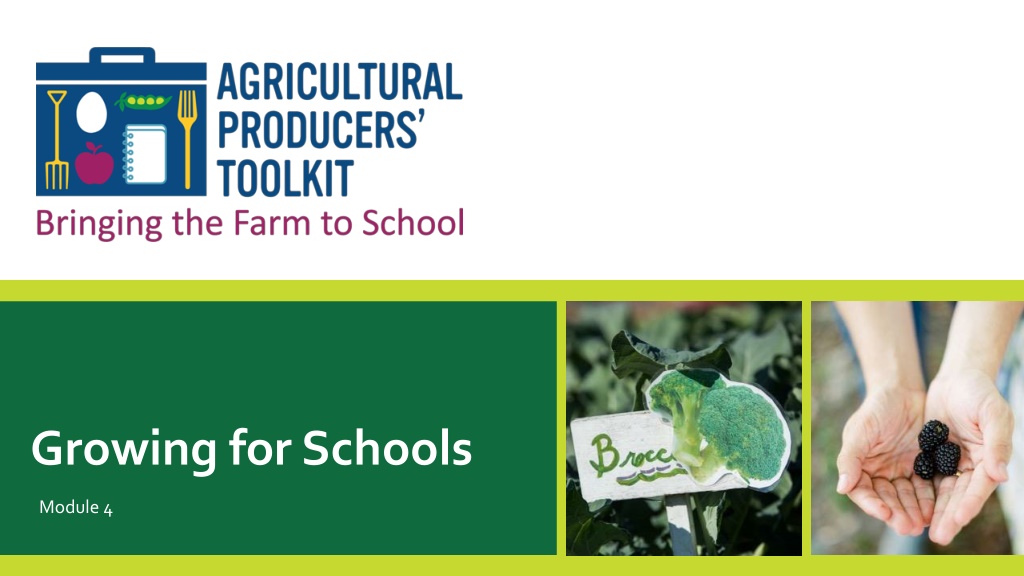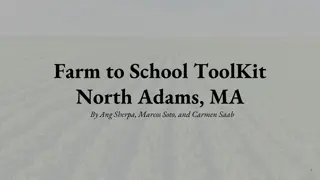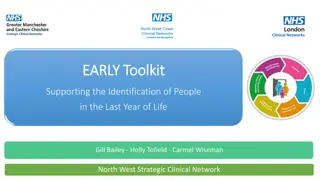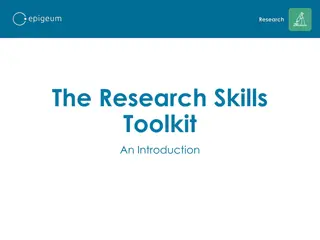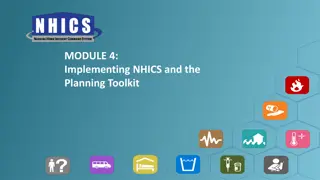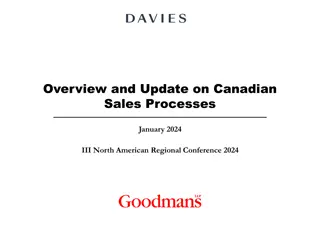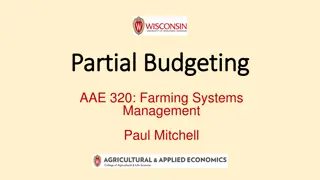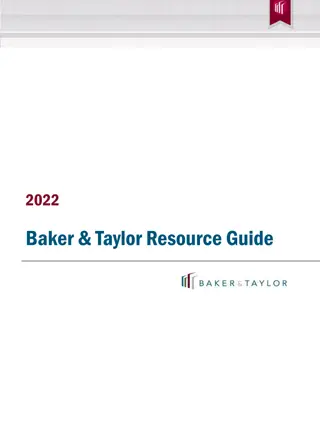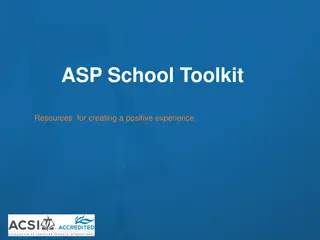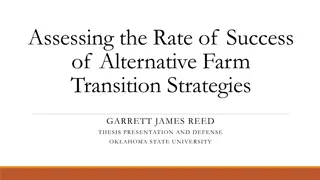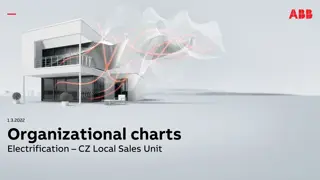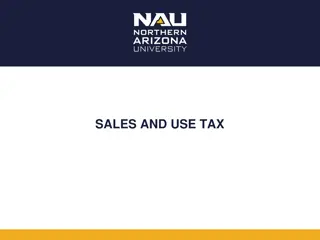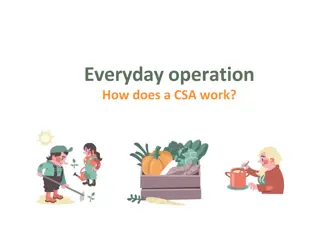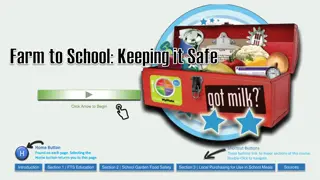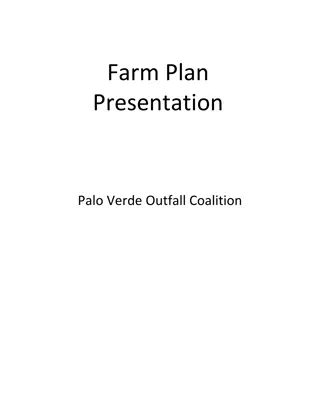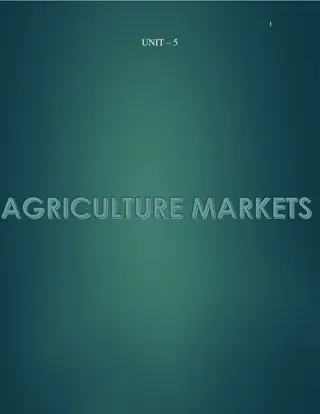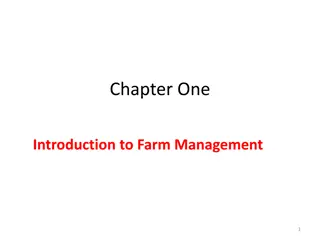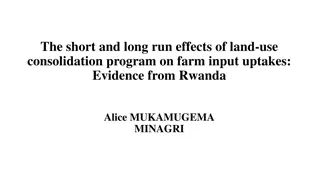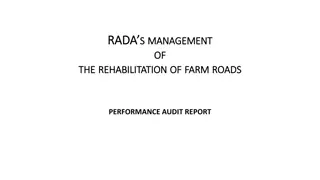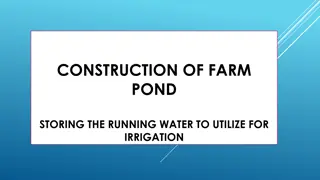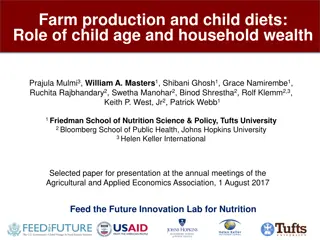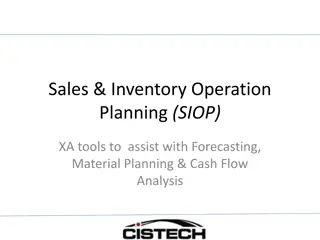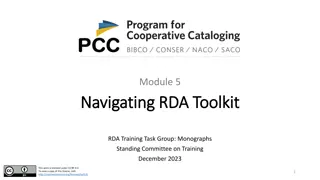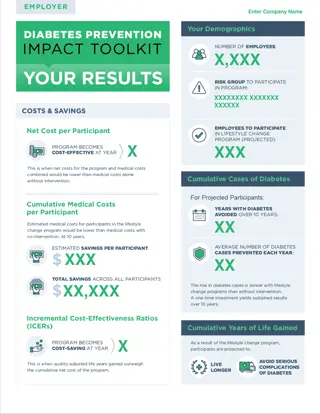Farm to School Sales Planning Toolkit
This toolkit provides valuable insights and guidance on selling products to schools, including assessing capacity, understanding price points, meeting infrastructure and food safety requirements, and planning the transition from farm to school market. It covers topics such as business planning, market channels, pricing strategies, breakeven points, and cost calculations using enterprise budgets. Additionally, it offers resources like cost calculators and practical activities to enhance learning.
Download Presentation

Please find below an Image/Link to download the presentation.
The content on the website is provided AS IS for your information and personal use only. It may not be sold, licensed, or shared on other websites without obtaining consent from the author. Download presentation by click this link. If you encounter any issues during the download, it is possible that the publisher has removed the file from their server.
E N D
Presentation Transcript
Growing for Schools Module 4
Learning Objectives Assess your capacity for selling to schools. Further explore price points for selling to schools. Understand the infrastructure, planning, and food safety requirements that are needed to move product into a school market. Learn best practices for planning to move your product from field to schools. 2 Bringing the Farm to School: Agricultural Producers Toolkit
Applied Activity Let's Play Jeopardy Categories: Farm Business Production Planning Food Safety Price Point Enterprise Budget GAP Break Even Price FSMA HACCP 3 Bringing the Farm to School: Agricultural Producers Toolkit
Section A: Business Planning for School Sales
From Goals to Planning Factors that affect how a product fits into the school menu Market channel School needs Adaptation based on price point Review of the marketing channels in selling to schools Direct to school Food hubs and aggregators Large distributors USDA Foods or Department of Defense (DoD) Fresh Photo: National Farm to School Network 5 Bringing the Farm to School: Agricultural Producers Toolkit
Price: Understanding Your Breakeven Price Point What are some examples of fixed costs? What are some examples of variable costs? Credit: National Farm to School Network 6 Bringing the Farm to School: Agricultural Producers Toolkit
How to Use an Enterprise Budget to Determine Break-even Price Know your costs Schools may have options to lower your costs Click for Enterprise Budgets Credit: University of MD Extension Program 7 Bringing the Farm to School: Agricultural Producers Toolkit
Cost Calculators What product are you most interested in producing for a school market? Oklahoma Farm to School Produce Calculator Veggie Compass Click above for resources 8 Bringing the Farm to School: Agricultural Producers Toolkit
Return on Investment Photo: University of Vermont Photo: National Center for Appropriate Technology Photo: VT Agency of Agriculture 9 Bringing the Farm to School: Agricultural Producers Toolkit
Producer Spotlight: Katrina Becker, Cattail Organic Photo: Cattail Organics 10 Bringing the Farm to School: Agricultural Producers Toolkit
Applied Activity Enterprise and Return-on-Investment-Costs Evaluation Worksheet 4A: Business Planning Considerations for School Sales Breakeven Price Identify products that have the highest potential for a school market based on break-even prices, existing infrastructure, and production capacity. Outline enterprise costs with the goal of determining break even costs for products sold to schools. Identify next steps to understand if break-even price will meet the school bidding sheet. 11 Bringing the Farm to School: Agricultural Producers Toolkit
Section B: Scaling Up Production Meeting Increased Demand for School Markets
Understanding Scales of Production Direct from the farm Food hub or co-op Farmers market Food processor Distributor Photos: National Center for Appropriate Technology 13 Bringing the Farm to School: Agricultural Producers Toolkit
Heading in the Direction of Farm to School One, and only one, weakest link accounts for the strength of the entire chain, regardless of how strong other links might be. To strengthen a chain, one must always attend first to the weakest link. Other links (adverse factors), no matter how frail they appear, are essentially non-problems until the weakest link is first fixed. - Savory, Butterfield. Holistic Management. 2016 Weak Links on the Farm Production Harvest and Post-harvest Quality Control Livestock Mechanical Business Management Financial Employees Communication and Decision Making Markets 14 Bringing the Farm to School: Agricultural Producers Toolkit
Sustainable Growth Return on Investment Break Even Cost Tools Equipment Buildings Hoophouses Loans and Debt Photos: National Center for Appropriate Technology 15 Bringing the Farm to School: Agricultural Producers Toolkit
Scaling Up Considerations Administrative systems Labor management Land access and quality Equipment and infrastructure Scaling up will affect: Acreage Crops Herd size Markets Photo: National Center for Appropriate Technology 16 Bringing the Farm to School: Agricultural Producers Toolkit
Labor As an agriculture employer, farmers MUST: Know federal and state laws See the following resources: https://www.dol.gov/agencies/whd/state/contacts https://www.dol.gov/agencies/whd/agriculture Set up an accounting system and keep receipts for: Income: 3 years Expenses: 3 years Payroll: 4 years Withhold payroll taxes Provide safe working conditions andcarry workers compensation insurance Photo: National Center for Appropriate Technology 17 Bringing the Farm to School: Agricultural Producers Toolkit
Selling to Schools Special Considerations Capacity, Consistency, Infrastructure School Food Service Directors requirements Food safety and production standards Washing, packing, or processing facility capacity Cooler and delivery truck space Accounting system to track sales and payments Capabilities to manage a larger staff Photo: National Farm to School Network 18 Bringing the Farm to School: Agricultural Producers Toolkit
Meeting the Budget Needs of Schools Volume Consistent quality and quantity Billing School requirements may impact cash flow Price Meet farm needs while charging what the school can afford Photo: National Farm to School Network 19 Bringing the Farm to School: Agricultural Producers Toolkit
Meeting School Grading, Packaging, and Labeling Requirements Farms may use a code system such as the following: Typical information on a label includes: Name and address of the farm Julian date 6/19 (170) Product Grade Quantity/count Harvest or pack crew identification Certifications e.g. Certified Organic, GAP Sp619Ac3 which represents spinach picked on 6/19 from field A by crew or person 3 20 Bringing the Farm to School: Agricultural Producers Toolkit
Food Safety Food safety plan Food Safety Modernization Act (FSMA) minimum standards FSMA exemptions and scaling up Photo: National Center for Appropriate Technology 21 Bringing the Farm to School: Agricultural Producers Toolkit
Managing Risks with Insurance 22 Bringing the Farm to School: Agricultural Producers Toolkit
Scaling Up: Final Considerations Is scaling up necessary Costs for expansion Rate of return Photo: National Farm to School Network Photo: National Farm to School Network 23 Bringing the Farm to School: Agricultural Producers Toolkit
Applied Activity Weakest Link to Consider Before Farm Expansion Worksheet 4B: Weakest Link and Developing Strategies for Improvement On the worksheet, write one or two deficiencies you are currently experiencing that could adversely affect your ability to scale up. One, and only one, weakest link accounts for the strength of the entire chain, regardless of how strong other links might be. To strengthen a chain, one must always attend first to the weakest link. Other links (adverse factors), no matter how frail they appear, are essentially non- problems until the weakest link is first fixed. Allan Savory and Jody Butterfield, Holistic Management International What is your weakest link? 24 Bringing the Farm to School: Agricultural Producers Toolkit
Section C: Crop Production and Planning
Producer Spotlight: Living Root Farm HowCan Crop-Production Planning Help with School Sales? Photo: Living Root Farm 26 Bringing the Farm to School: Agricultural Producers Toolkit
Planting Plan- Schools are reliable and help with planning! Determine demand and work back from harvest to planting. Identify those harvest targets and space requirements. Yield calculations will help youidentify the amount of space required. What is your production goal? Consider plant spacing and number ofrows/plants/acres. How much seed will be needed? Johnny s Seed Calculator Johnny s Selected Seeds 27 Bringing the Farm to School: Agricultural Producers Toolkit
Crop Planning: It Is Not a Perfect World Factor in crop loss Figure in extra plants in the field and extra seed for germination loss approx. 20% for plants or seeds Harvest window and crop succession Photo: National Center for Appropriate Technology 28 Bringing the Farm to School: Agricultural Producers Toolkit
Recordkeeping and Monitoring How do you know yield and space requirements for your product? Track and write it down! Historic data Measure your efforts Record measurements Use to estimates future expenses and revenues Credit: National Center for Appropriate Technology 29 Bringing the Farm to School: Agricultural Producers Toolkit
Applied Activity Crop Planning Exercise Worksheet 4C: Crop Planning Exercise Using the bid sheet in Appendix C and seed, yield, and planting charts, determine plot size and number of seeds/plants needed to meet the bid. Photo: National Farm to School Network 30 Bringing the Farm to School: Agricultural Producers Toolkit
Section D: Animal Protein Production Planning
Applied Activity How Do Your Livestock Products Fit on the Plate? Learn the school needs for meat and egg production. Understand livestock planning based on demand, yield projections, and production goals. Assess schedules for sustained delivery and profitability. Photos: National Center for Appropriate Technology 32 Bringing the Farm to School: Agricultural Producers Toolkit
How Do Your Products Fit with School Demands? Proteins are the most expensive part of a school lunch meal Consider: Cost Versatility 33 Bringing the Farm to School: Agricultural Producers Toolkit
Producer Spotlight: Bear Paw Meats Beef to School Listen to Karla Buck from Bear Paw Meats: https://attra.ncat.org/selling-beef-to-schools-podcast/ Photo: Karla and Dexter Buck, Beat Paw Meats 34 Bringing the Farm to School: Agricultural Producers Toolkit
Determine School Needs Portion size Product volume demand Versatility Packaging and Processing - Niche Meat Processor Assistance Network Photo: Lower Valley Processing; Montana Beef to School Program 35 Bringing the Farm to School: Agricultural Producers Toolkit
Assess Current Production What is your production potential, in pounds and specific cuts? What is your break-even price? Do you have the acreage and grazing/feeding management skills to produce at the scale needed and sell your products above break-even cost? Graphic: University of Tennessee Institute of Agriculture Photo: NCSU Growing Small Farms 36 Bringing the Farm to School: Agricultural Producers Toolkit
Plan Production Based on Demand Assess production capacity Tools for assessing production capacity and profitability: Livestock Compass Working with your Meat Processor Click here to access resource Photo: Montana Highland Lamb 37 Bringing the Farm to School: Agricultural Producers Toolkit
Eggs Considerations: number of birds, infrastructure, processing, and packaging How much product does the school need each week? Do you have the capacity to deliver or scale up for production? Consider factors such as seasonal changes, summer vs. winter production, number of birds, etc. Grading; minimally processed product Photo: National Center for Appropriate Technology 38 Bringing the Farm to School: Agricultural Producers Toolkit
Applied Activity - Capacity andProduct Assessmentfor Livestock Producers Worksheet 4D: Capacity and ProductAssessment Assess your capacity for delivering livestock products to schools Photo: Jeremy Prater Photo: Linda Coffey 39 Bringing the Farm to School: Agricultural Producers Toolkit
Section F: Navigating School Food Safety Standards
Producer Spotlight: Myth Busting- Food Safety Requirements in Schools Communicating Food Safety Practices with Your School Buyer;Common Ground Farm, New York State Production by: Spinach World Multimedia 41 Bringing the Farm to School: Agricultural Producers Toolkit
Finding School Food Safety Requirements School Product Specifications Product & variety Quality standards & size Food Safety as a vendor requirement Quantity Post-harvest handling freshness Packing & labeling Traceability Other terms and conditions Photo: National Farm to School Network 42 Bringing the Farm to School: Agricultural Producers Toolkit
Other Buyers Food Safety Requirements 43 Bringing the Farm to School: Agricultural Producers Toolkit
FSMA, GAPs, HACCP: Whats the Difference? 44 Bringing the Farm to School: Agricultural Producers Toolkit
Where to Get Help with Food Safety County Extension Offices Produce Safety Alliance Grower Training Course State Departments of Agriculture Agriculture Marketing Service GAP Auditor list Photo: National Center for Appropriate Technology 45 Bringing the Farm to School: Agricultural Producers Toolkit
Meat School Sales and Food Safety Regulations Agencies responsible for establishing the rules and regulations USDA Food Safety and Inspection Service(FSIS) Department of Health and Human Services (DHHS) Food and Drug Administration (FDA) USDA Food and Nutrition Service (FNS) State and local governments adopt Federal regulations and issue permits Click link for resource 46 Bringing the Farm to School: Agricultural Producers Toolkit
Food Safety Planning Tools for Accessing School Markets Digging Deeper Resources ATTRA Produce Safety Tutorial Farm-Based Food Safety videos Farmer Regulatory Toolkit Understanding Food Safety Regulations and Performing a Self Assessment Tips, Tools, and Guidelines for Food Distribution and Safety, OK Farm to School The Seven Principles of HACCP, University of Nebraska Lincoln ATTRA Podcast: A Conversation with Atina Diffley ATTRA Video: The Internal GAP Audit Overview Click the above photo to access the podcast 47 Bringing the Farm to School: Agricultural Producers Toolkit
Applied Activity Producer Food Safety Communication Tool Worksheet 4E: Communicating your FoodSafety Protocols to School Food Authorities Risk Assessment The food safety risk assessment is a tool you can use to : (1) Assess your risk management activities and (2)Describe how you manage risks to buyers to demonstrate how you address food safety issues on your farm. 48 Bringing the Farm to School: Agricultural Producers Toolkit
Action Planning Checking In I understand the break-even price pointI need for my products to enter or expand into school sales. I understand the weak links to consider before scaling up my farm(e.g., infrastructure, food safety, distribution, etc.). I have the beginning of a production plan for my product(s). Iunderstand andcan communicate my food safety practices toSchoolFoodAuthorities. 49 Bringing the Farm to School: Agricultural Producers Toolkit
The Bringing the Farm to School: Agricultural Producers Toolkit was developed in partnership by USDA Food and Nutrition Services, the National Center for Appropriate Technology, and the National Farm to School Network. Click to enter Facilitator's Name Click to enter Facilitator s Title Phone: (XXX) XXX-XXXX Email: www.xxxxxx.com
